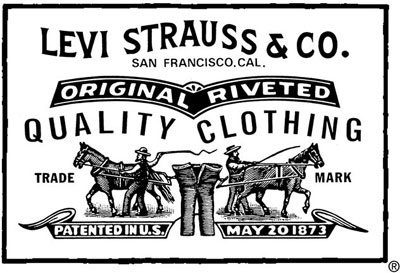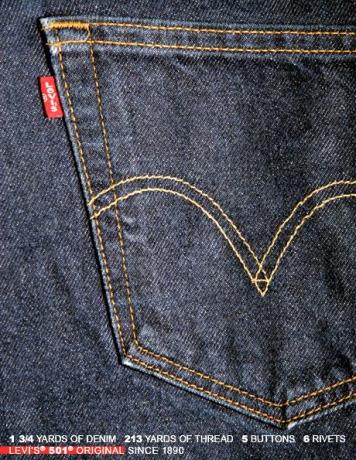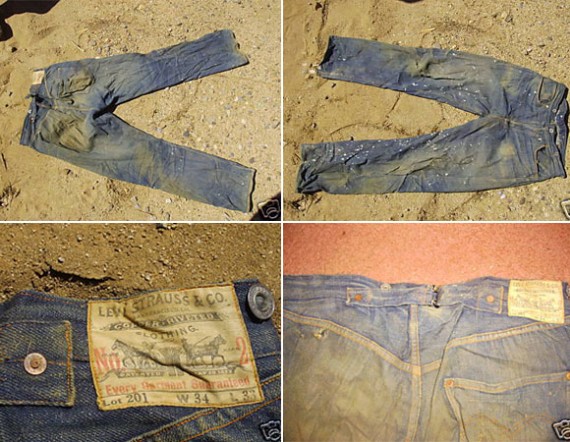The Levi’s brand, which symbolizes the USA, was founded by two imigrants, Levi Strauss (Löeb Strauss), a merchant from Bavaria, and Jacob Davis (né Jacob Youphes), a tailor from Latvia, who came to America in mid 50s of the 19th century (the detailed story is on Levi Strauss & Co page).
Strauss had a boosting dry-goods store chain, and provided the gold diggers, who came to get fortune in the California gold rush and the tailors with canvas. He started to use a tough, brown cotton cloth made in Nîmes, France (serge de Nîmes, which was shortened to “denim”) and had it dyed with indigo for making blue material.
One of tailors, Jacob Davis from Reno Nevada sent a letter to Strauss, from whom he purchased the material from time to time, to share the expanses on patenting his new invention — rivets on pants — which prevented the pockets from being torn off. The businessman accepted the offer and on May 20, 1873 Levi Strauss & Jacob Davis received a patent number 139,121 on riveting pants by the U.S. Patent and Trademark Office. That is when the blue jeans as we know it now appeared. In fact, the company didn’t invent the cut or fit of the waist overalls, it just riveted it, making the new version of men workwear. It had a single back pocket with the Arcuate stitching and a watch pocket with copper rivets. Since 1890 the rivet technology became widely applied after it went into the public domain.

The company started producing the original 501® jean, and then it was called just “XX”, which meant the highest quality of blue denim used for making waist overalls in those times. Now it remains unclear why the producers started using the Arcuate stitching and when the first factories were open, because the in 1906 earthquake and fire destroyed the company’s documentation. The founder of the brand who gave it his name, Levi Strauss died at the age of 73 in 1902 and the company was headed by his nephew (the business is still owned by his descendants). In 1928 the company decided give their jeans a real name, and so Levi’s® appeared a trademark.
In 1934 LS&CO creates «Lady Levi’s®,» the company’s first blue jeans for women, making the denim pants to be a widely-used item of clothes regardless to sex, social status or income. The brand became extremely popular among folks and even became trendy. During the WWII period the non-vital decoration had to be removed from the jeans to save fabric and metal. But to preserve the unique style, the brand had an arcuate, which is registered as the company’s trademark in 1943, was hand pained on each pair of Levi’s.
In the second half of the 20th century Levi’s jeans enter the world market. In 1967, the brand exhibited its jeans in Moscow, Prague and Warsaw. Levi’s that combined vintage, modernity and high quality started to be warmly welcomed in any country on the globe thanks to popularizing by youth movements of punks, rockers and hippies.
• The Horsebrand leather patch on the back of the waist overalls, which were later called jeans, first appeared in 1886. Two horses are dragging a pair of Levi’s denim pants in the opposite directions. The emblem symbolizes the top-quality and strength of the jeans. In late 1950s the leather patch was replaced by heavy-duty card stock patch to reduce expenses.
• In 1901, the manufacturers add one more back pocket to the overalls.
• In 1935, Levi’s were featured in Vogue. The fashion magazine mentioned the women line in an article about dude ranching.
• In 1936, the jeans first get the red tab on the right back pocket with the word “LEVI’S” stitched in white in all capital letters. In 1971, the lettering was changed and only the first letter remained capital.
• 1964, Levi’s jeans become an integral part of Smithsonian Institution collections.
• The “batwing”, a new brand’s trademark, was introduced in 1967.
• The most expensive original Levi’s jeans were bought on the eBay auction on May 25, 2001. They cost $46,532 and turned to be at least one hundred years old. The item from Nevada mining town was purchased by the official historian of «Levi’s Strauss and Co. and later became the sample for 500 limited-edition vintage collection denim pants sold $300 per each.


